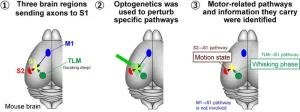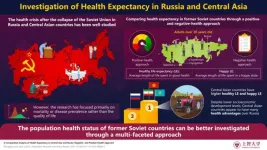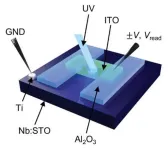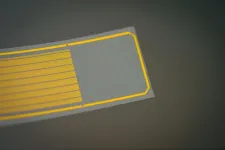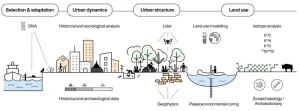Chemical Insights Research Institute commits to public health research with the opening of new laboratories
2024-01-11
(Press-News.org) ATLANTA – Chemical Insights Research Institute (CIRI) of UL Research Institutes confirmed its commitment to protecting environmental and human health when it opened its new research laboratories supporting scientific studies of environmental exposure and its societal health impact. At a ribbon cutting today, CIRI introduced the Center for Exposure Science; the Center for Toxicology and Human Health; and the Center for Advanced Measurements, each with a designated, cutting-edge laboratory.
Using the latest tools for measuring nanosized particles and parts per billion levels of chemicals and developing high-throughput cellular techniques for measuring human toxicity, these Science Centers are on the frontlines of investigating chemicals in the air we breathe, the water we drink, and the products we interact with every day, and measuring their impact on human health.
CIRI’s staff of more than two dozen research scientists, educators, and communicators are tackling critical issues on emerging environmental health threats facing people and the planet today. Its work provides people around the world with objective research and knowledge for improved practices, innovative product design, and changes that enable safer products and healthier environments.
“The opening of these laboratories comes at a critical moment in environmental history,” said Marilyn Black, Ph.D., Vice President and Senior Technical Advisor at CIRI. “Wildfires striking in urban interface areas with increased frequencies in places like Hawaii and Canada; 3D printers growing in popularity in school systems with unknown health consequences; and building materials impacting the built environment and occupant health as infrastructure is climate challenged, are among the primary concerns for our scientists.”
CIRI combines the best minds with rigorous scientific research and a commitment to thorough and accurate research studies. Partnering with renowned research institutions such as the Massachusetts Institute of Technology, Georgia Institute of Technology, Duke, Harvard, Emory, and other universities, helps to expand CIRI’s research platform for knowledge. Evolving from its research findings, CIRI shares scientific insights in actionable ways so educators, manufacturers, healthcare providers, consumers, and policy makers can make informed environmental health decisions and extend lives.
“This is a proud moment for UL Research Institutes (ULRI),” said Chris Cramer, Ph.D., Interim President and Chief Research Officer of ULRI. “CIRI’s work is terrifically influential and has improved public health globally. Every day, CIRI plays a critical role as we address our grand challenge commitments to build resilience for a sustainable future and improve individual and societal health in the 21st century.”
CIRI’s current research includes environmental and public health impacts associated with:
Wildfires
Climate change and building infrastructure
PFAS, flame retardant, and other chemical exposures
Global indoor and outdoor air pollution
Health resiliency and vulnerable populations
3D printing
E-cigarettes and vaping
For more information on CIRI, please visit www.chemicalinsights.org.
# # #
About Chemical Insights Research Institute:
Chemical Insights Research Institute (CIRI) of UL Research Institutes is a nonprofit organization dedicated to scientific research, publication, education, and communication on environmental exposures resulting from technologies and practices, their impact on human health, and processes for reducing health risks. CIRI provides actionable data and resources to help manufacturers, educators, healthcare providers, and consumers make informed environmental health decisions and risk reduction strategies for the protection of human health.
About UL Research Institutes
UL Research Institutes is a nonprofit research organization dedicated to advancing public safety through scientific discovery. Since 1894, our research has advanced our mission toward a safer, more secure, and sustainable future. Focused on global risks from fire mitigation and air quality to safe energy storage and digital privacy, we conduct rigorous independent research, analyze safety data and partner with experts to uncover and act on existing and emerging risks to human safety.
Media Contact:
Bert Kelly
(470) 957-7854
Bert.kelly@ul.org
END
ELSE PRESS RELEASES FROM THIS DATE:
2024-01-11
The brain is widely considered the most complex organ in the human body. The intricate mechanisms through which it processes sensory information and how this information affects and is affected by motor control have captivated neuroscientists for more than a century. Today, thanks to advanced laboratory tools and techniques, researchers can use animal models to solve this puzzle, especially in the mouse brain.
During the 20th century, experiments with anesthetized mice proved that sensory inputs primarily define neuronal activity in the primary ...
2024-01-11
The dissolution of the Soviet Union in 1991 marked the start of a period ripe with political, economic, and societal changes. In many former Soviet countries, these abrupt and turbulent transformations posed massive challenges to healthcare systems. Together with spikes in job losses and economic hardships, this led to a steep increase in mortality rates that would later come to be known as the “post-Soviet mortality crisis.”
However, this crisis did not affect all former Soviet countries equally. In particular, former Soviet countries in Central Asia, which include Kazakhstan, Kyrgyzstan, Tajikistan, Turkmenistan, and Uzbekistan, saw a ...
2024-01-11
Every day, a significant amount of data related to weather, traffic, and social media undergo real-time processing. In traditional cloud computing, this processing occurs on the cloud, raising concerns about issues such as leaks, communication delays, slow speeds, and higher power consumption. Against this backdrop, “edge computing” presents a promising alternative solution. Located near users, it aims to distribute computations, thereby reducing the load and speeding up data processing. Specifically, edge AI, which involves AI processing at the edge, is expected to find applications in, for example, self-driving ...
2024-01-11
Fukuoka, Japan—In a study published in Science Advances, a group of researchers led by Associate Professor Nobuhiro Yanai from Kyushu University's Faculty of Engineering, in collaboration with Associate Professor Kiyoshi Miyata from Kyushu University and Professor Yasuhiro Kobori of Kobe University, reports that they have achieved quantum coherence at room temperature: the ability of a quantum system to maintain a well-defined state over time without getting affected by surrounding disturbances
This breakthrough was made possible by embedding a chromophore, ...
2024-01-11
PULLMAN, Wash. -- Researchers have taken the first steps toward finding liquid solvents that may someday help extract critical building materials from lunar and Martian-rock dust, an important piece in making long-term space travel possible.
Using machine learning and computational modeling, Washington State University researchers have found about half a dozen good candidates for solvents that can extract materials on the moon and Mars usable in 3D printing. The work, reported in the Journal of Physical Chemistry B, is led by Soumik Banerjee, associate professor in WSU’s School of Mechanical ...
2024-01-11
Where we live and work, our age, and the conditions we grew up in can influence our health and lead to disparities, but these factors can be difficult for clinicians and researchers to capture and address. A new study by investigators from Mass General Brigham demonstrates that large language models (LLMs), a type of generative artificial intelligence (AI), can be trained to automatically extract information on social determinants of health (SDoH) from clinicians’ notes which could augment efforts to identify patients who may benefit from ...
2024-01-11
Researchers at the University of California San Diego have developed a neural implant that provides information about activity deep inside the brain while sitting on its surface. The implant is made up of a thin, transparent and flexible polymer strip that is packed with a dense array of graphene electrodes. The technology, tested in transgenic mice, brings the researchers a step closer to building a minimally invasive brain-computer interface (BCI) that provides high-resolution data about deep neural activity by using recordings from the brain surface.
The work was published on Jan. 11 in Nature Nanotechnology.
“We are expanding the spatial ...
2024-01-11
Cities play a key role in climate change and biodiversity and are one of the most recognizable features of the Anthropocene. They also accelerate innovation and shape social networks, while perpetuating and intensifying inequalities. Today over half of all humanity lives in cities, a threshold which will rise to nearly 70% by the mid-21st century. Yet despite their importance for the Anthropocene, cities are not a recent phenomenon.
In a new study, an interdisciplinary team of authors from the Max Planck Institute of Geoanthropology ...
2024-01-11
Francis Crick Institute press release
Under strict embargo: 10:00hrs GMT 11 January 2024
Peer reviewed
Observational study
People
First prehistoric person with Turner syndrome identified from the Iron Age
Earliest known person with Jacob’s syndrome identified from Early Medieval Period
Individuals with Klinefelter syndrome identified across a range of time periods
New technique developed to measure number of chromosomes in ancient genomes more precisely
Researchers at the Francis Crick Institute, working with University of Oxford, University of York ...
2024-01-11
Researchers have linked a decade-long decline in the blood lead levels of American Indian adults to long-term cardiovascular health benefits, including reduced blood pressure levels and a reduction in a marker associated with hypertrophic cardiomyopathy and heart failure. The research team, supported by the National Institutes of Health, found that adults who had the greatest reductions in blood lead levels saw their systolic blood pressure fall by about 7 mm Hg, an amount comparable to the effects of blood pressure-lowering medication. Lead exposure is known to harm the health of children by damaging the brain and nervous system and slowing growth and development. It has also been associated ...
LAST 30 PRESS RELEASES:
[Press-News.org] Chemical Insights Research Institute commits to public health research with the opening of new laboratories
